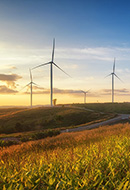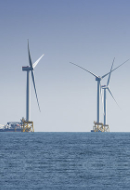Types of wind: Characteristics and impact on weather
What are the different kinds of wind?
Wind is the movement of air in the atmosphere, caused by differences in pressure between different areas. It regulates the global climate by distributing heat and moisture, as it can carry warm air from the equator towards the poles, cold air in the opposite direction and transport humidity, which influences rainfall patterns. Depending on their origin and characteristics, different types of wind can create humid, arid or extreme climates, directly affecting daily life. Below we review the types of wind, their role in wind-power generation and how they influence the energy industry.

November 2025

Approximately 15 minutes

As well as being a climate regulator, wind is the cornerstone of wind energy, which transforms its force into clean, sustainable electricity through wind turbines. This source helps reduce emissions, diversify the energy mix and create jobs, although its use depends on the natural variability of the wind.
To better understand the role of wind, it is important to know its main types, which are grouped into two categories: small-scale winds, such as local winds, and large-scale winds, which are currents that affect the planet globally and cause changes in atmospheric pressure.
Small-scale winds
A clear example of a local wind is the sea breeze. On sunny summer days, the sun heats the land quickly, while the sea, due to its slower heat absorption, remains cooler. This temperature difference between the warm land and the cooler sea creates a thermal contrast.
As the land warms, the air above it also heats up. This warm air becomes less dense than the surrounding cooler air and begins to rise, like bubbles in a pot of boiling water. This rising air creates a low-pressure zone over the land, while the air over the sea, being cooler and denser, maintains higher pressure.
This pressure difference causes air to move from the sea towards the land to equalize the pressures. This movement is what we know as the sea breeze. That is why coastal areas are often much cooler than inland areas on a hot, sunny day.
A similar phenomenon occurs with valley breezes. During the day on a slope, the air close to the ground heats up more than the surrounding air, creating lower pressure that induces wind moving up the valley. At night, the air near the ground cools, becoming denser and descending, forming a mountain breeze, or katabatic wind.
There are several types of small-scale winds, including:
Sea breeze
Winds caused by temperature differences between land and sea, following daily cycles. The sea breeze (from the sea to the land) strengthens during the day, while the land breeze (from land to sea) occurs at night.
Valley breeze
During the day, greater heating of elevated terrain compared with its surroundings generates wind moving up the valley. At night, cooling near the ground causes air to descend from higher areas, forming katabatic wind. Sometimes this wind can be sudden, very strong and gusty, creating dangerous conditions if it combines with larger-scale phenomena. Examples include the Bora (in the Adriatic) and the Piteraq (in Greenland), which produce strong gusts and pronounced waves near the coast.
Foehn wind
When upper-layer winds descend rapidly along mountain slopes, the air compresses and heats up. This can cause sudden temperature changes, dry conditions and strong gusts in regions beyond the mountains.
Seasonal winds, such as the monsoons in the Indian Ocean and parts of Asia, are seasonal wind reversals. For several months, the winds are strong and consistent in one direction, bringing rain, before returning to their predominant direction.
Large-scale winds
Trade winds: They blow consistently from high-pressure zones in the subtropical belts towards the low-pressure region at the equator. Westerlies: The most common winds in the mid-latitudes, usually associated with low-pressure systems. Polar easterlies: Originate in the high-pressure areas near the poles. Jet streams: Extremely fast air currents in the upper troposphere, responsible for the predominance of west-to-east winds in the mid-latitudes
Wind speed and its categories by intensity, and effects at sea
What’s more, wind can be classified into different categories according to its speed, each with specific characteristics in terms of intensity and effects at sea.








- 0
- 10
- 20
- 30
- 40
- 50
- 60
- 70
Breezes cover the gentlest ranges.
Strong winds have greater intensity.
 SEE INFOGRAPHIC: Wind speed and its categories by intensity, and effects at sea [PDF]
SEE INFOGRAPHIC: Wind speed and its categories by intensity, and effects at sea [PDF]
In short, winds can be classified as small-scale or large-scale, but they can also be measured by their intensity and effects at sea. Small-scale winds, such as sea breezes, are gentle and mainly affect coastal areas, while large-scale winds, driven by global circulation and influenced by the Coriolis effect, give rise to prevailing winds such as the trade winds and the westerlies. In terms of intensity, winds range from light breezes, with small waves, to severe storms, with conditions varying from a gentle breeze to gales and full storms, producing waves that can exceed seven meters in the most extreme cases.

Wind Energy
What is it, how is it converted into electricity and what are its advantages?

Wind measurement
Find out how to choose the location of a wind farm.

Global Wind Day
Iberdrola joins the annual celebration of World Wind Day on 15 June.

Documentary on offshore wind energy
'United by the wind', the most social side of offshore wind energy.
How is wind speed measured?
Accurately measuring wind speed is essential for weather forecasting, planning activities and efficiently harnessing its energy. Various tools are used for this, ranging from simple mechanical devices to sophisticated remote-sensing technologies capable of studying wind at different heights and in real time. The most commonly used instruments are the anemometer and wind speed sensors.
Anemometer
An anemometer is an instrument designed to measure wind speed in a specific direction and plane. Its basic operation involves recording the movement caused by the wind and converting it into a speed measurement. Anemometers are used in fields as diverse as meteorology, aviation, maritime navigation, engineering and scientific research.
They are used to anticipate weather changes, plan operations and ensure safety, as wind speed influences phenomena such as storms, wave height and turbulence. Even in the aerospace sector, laser versions are used to study airflow around spacecraft and probes, as planned for future missions to Venus.
There are several types:
- Cup anemometer: the most common in weather stations, with three or four hemispherical cups rotating around a vertical axis; the revolutions per unit of time determine the average wind speed.
- Vane or propeller anemometer: uses a horizontal rotor aligned with the wind flow, common in portable measurements or wind tunnels.
- Hot-wire anemometer: measures the cooling of a metal wire heated by an electric current. It is highly precise at very low speeds and responds quickly.
- Thermo-anemometer: combines measurement of air speed and temperature.
- Hygro-thermo anemometer: adds a humidity sensor to provide comprehensive environmental data.
- Thermal anemometer: similar to the hot-wire type, allows analysis of both speed and temperature, used for detailed airflow studies.
In terms of accuracy, cup and vane models are reliable for moderate to strong winds in open spaces, while hot-wire and thermal anemometers provide highly precise readings at low speeds or in controlled environments. The choice of type depends on the measurement conditions and the required level of detail.
Wind speed sensor
The most advanced wind speed sensors use ultrasonic and laser technologies, offering higher precision and faster response than traditional mechanical anemometers. Ultrasonic anemometers determine speed by calculating the time it takes for a sound wave to travel between two transducers, allowing highly stable measurements even in turbulent conditions or with rapid changes in wind direction.
Meanwhile, LiDAR (Light Detection and Ranging) and SoDAR (Sonic Detection and Ranging) systems can measure wind at various heights, from tens to hundreds of meters, which is essential for the assessment and optimisation of wind farms. In meteorology, these sensors improve the prediction of extreme events and the monitoring of atmospheric patterns, while in the wind energy industry they help maximize production and extend the lifespan of turbines through more precise operational control.
The key distinction: electricity vs heat
Electricity and heat are different forms of energy: electricity is energy capable of powering devices, systems and infrastructure through the flow of an electric current, while heat is thermal energy associated with an increase in the temperature of a body or medium.
Operational characteristics: power and duration
The power and duration of the wind are key factors in the capacity for wind energy generation. The power available in the wind increases exponentially with its speed, meaning small increases in air velocity result in significant increases in energy produced. However, strong wind alone is not enough: it must also blow for prolonged and consistent periods.
To calculate these factors, continuous records of wind speed and direction are collected throughout the year using anemometers and LiDAR or SoDAR technologies. These data allow the estimation of a wind turbine’s capacity factor, which is the percentage of energy actually produced compared with the amount it could generate if it operated at full power continuously. A site with moderate but consistent winds may be more efficient than one with intense but sporadic gusts.
Wind and its relationship with the climate
Wind is an essential element of the climate, as it redistributes heat and moisture across the planet. Its behaviour is determined by the interaction between solar radiation, the Earth’s rotation and the characteristics of the surface (seas, mountains, plains). These air flows not only influence the temperature and precipitation of each region but also determine the feasibility of harnessing wind as an energy resource.
Wind speed and direction are critical factors affecting the performance of wind turbines. As wind speed increases, the energy generated by a turbine also rises. Understanding wind patterns is key to planning wind projects and anticipating seasonal or extreme variations that may affect production.
Winds and climate change
Climate change is altering wind patterns worldwide. Global warming modifies the distribution of atmospheric pressure and surface temperatures on land and sea, which can intensify some winds while weakening others. It also affects large-scale currents such as the jet stream and monsoons, with direct consequences for rainfall, droughts and the frequency of extreme events. For wind energy, these changes can lead to variations in resource availability and affect the planning of new wind farms, requiring more precise climate models to ensure investment and efficiency.
Ways to harness wind: electrical and mechanical
Wind can be harnessed to produce electrical energy and direct mechanical energy.
Iberdrola, a leader in wind energy worldwide
At Iberdrola, we have become one of the world’s leading companies in the development and operation of wind projects, both onshore and offshore. With a presence in around 30 countries and thousands of turbines in operation, we combine technological innovation, sustained investment and environmental commitment. Our projects range from large offshore wind farms such as Wikinger and East Anglia ONE to advanced wind-measurement programmes using technologies such as LiDAR to optimise performance. These initiatives are part of our sustainable-development strategy, aimed at achieving a decarbonised energy system, reducing dependence on fossil fuels and actively contributing to the fight against climate change.













